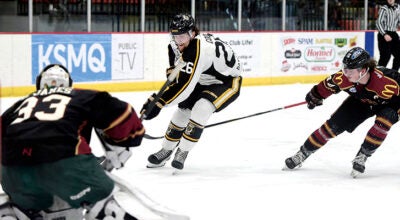D-Day part one: Planning
Published 6:49 am Tuesday, June 4, 2019
Thursday will mark 75 years since the launching of Operation Overlord, the invasion of Normandy in Northern France that opened the Western Front in Europe in the war against Nazi Germany. Known more commonly as “D-Day,” Operation Overload was the largest amphibious invasion in military history. Its success was apparent, as any history textbook will tell you. But at the time it was planned and executed, success was not a certainty.
This is how it began.
Operation Jubilee
On Aug. 19, 1942, a force of over 6,000 British and Canadian troops, along with several U.S. Army Rangers, launched Operation Jubilee, an amphibious attack on the Normandy town of Dieppe, France. The ensuing battle, dubbed the Dieppe Raid, was a disaster for the Allies, with 60 percent of those who went ashore killed, captured or wounded.
But while it was a setback, Dieppe proved to be a major lesson for the Allies. They learned that in order to launch a successful amphibious attack, they would need to gather intelligence on enemy positions, provide artillery support/aerial bombardment, and maintain the element of surprise.
“The Big Three”
In November 1943, President Franklin Roosevelt met with British Prime Minister Winston Churchill and Soviet Premier Josef Stalin in Tehran, Iran. At this point, the Soviets had been fighting a long battle with the Germans on the Eastern Front. American and British troops, having defeated the Germans in North Africa, were attacking the “soft underbelly” of Europe in Italy. Churchill advocated more military activity in the Mediterranean, but Stalin preferred a cross-channel invasion of Europe from Great Britain. Roosevelt agreed with Stalin, and Churchill reluctantly agreed to make the cross-channel invasion the top priority.
It was at Tehran that Roosevelt selected Gen. Dwight Eisenhower as the commander for the invasion. This was a surprise to Churchill and Stalin, who preferred U.S. Chief of Staff Gen. George Marshall. Eisenhower, however, had the ability to get along with American and British leaders, making him a better choice. British Field Marshal Bernard Montgomery was given command of the Allied ground forces that would participate as well as the responsibility of planning most of the invasion.
Picking a target
Several factors contributed to the selection of Normandy for the cross-channel invasion.
Another lesson taken from the Dieppe Raid was to not directly attack a defended port city; however, the capture of a port city would be valuable in resupplying invading troops. The coast of Normandy lies between two port cities: Cherbourg in the west and Le Havre in the east. It also lies east of the Cotentin Peninsula, which protects it from the prevailing westerly winds of the English Channel.
But the most significant factor was that the Germans believed an Allied invasion would come at the Pas de Calais in Northeast France. This belief came from a massive Allied deception campaign known as Operation Bodyguard, which incorporated the use of false messages meant to fall into German hands as well as phantom and dummy armies to be spotted by German aerial reconnaissance to convince them the invasion would come at different targets. While other supposed targets included the Balkans, Norway and Southern France, the Pas de Calais was the shortest distance between France and Great Britain, only 20 miles from England across the Strait of Dover. The Germans were further convinced by Juan Pujol, a double agent with the code name “Garbo,” that the invasion would come from the Pas de Calais (Pujol continued to convince the Germans of this even after the Normandy invasion began). Messages intercepted by the Allies confirmed the Germans had strengthened their defenses and increased their troop presence in the Calais area.
Preparations
June 5, 1944, was selected as D-Day for Operation Overlord, “D-Day” meaning the beginning date of an important operation.
The invasion plan divided the coast of Normandy into five beachheads: Utah, Omaha, Gold, Juno and Sword. The American Fourth Infantry Division would attack Utah Beach while the American First and 29th Infantry Divisions would attack Omaha Beach. The British 50th Infantry and Third Infantry Divisions were selected to attack Gold and Sword Beaches, respectively, while the Canadian Third Infantry Division would attack Juno Beach. Gen. Omar Bradley was selected to command the American troops while Gen. Miles Dempsey commanded the British and Canadian troops.
In the early morning hours before the beach landings, airborne troops would be dropped in behind enemy lines. The American 82nd and 101st Airborne Divisions would jump in behind Utah beach to help secure the beach exits and protect the flank from German reinforcements. The British Sixth Airborne Division was selected to jump behind Sword Beach with the task of destroying a German artillery battery overlooking the beachhead and capturing a bridge (later named “Pegasus Bridge”) over the Caen Canal near the town of Bénouville.
Once the beaches were secure, American forces would drive northwest up the Cotentin Peninsula and capture Cherbourg, giving the Allies their port city, while the British and Canadians would move west toward the important road juncture of Caen, the anchor point for the beachhead.
For weeks leading up to the invasion, Allied ground and airborne troops studied sand tables, maps and diagrams of their respective beachheads, memorizing landmarks and routes that led to their objectives. In the days leading up to the invasion, Allied aircraft attacked French roadways, railroads and bridges in Normandy as a means to prevent German troops from reinforcing their garrison.
In all, 1.5 million American troops were brought from the United States and the Mediterranean to Great Britain. The invasion would incorporate 600 warships, 4,000 landing craft/transports and 12,000 planes, an amphibious force the likes of which the world had never seen and has never seen since.
Delay
As Allied forces prepared for the invasion, stormy weather on June 4 forced Eisenhower to postpone. Weather reports indicated that bad weather could continue for almost two weeks, threatening to delay the invasion even further.
Confident that bad weather would bog down any Allied attack, German leaders relaxed. Field Marshal Erwin Rommel, who commanded the German defenses in parts of Northern France, Belgium and Southern Netherlands, confidently returned home to Germany to celebrate his wife’s birthday.
But on June 5, Eisenhower received a report indicating the weather would clear up later that day and continue into the morning of June 6. It was the window of opportunity he needed.
The invasion was a go.
Read D-Day part two here: Airborne assault
Read D-Day part three here: The beaches of Normandy




